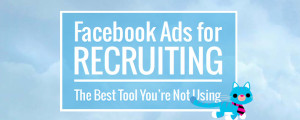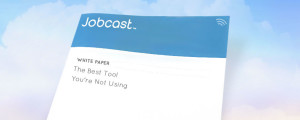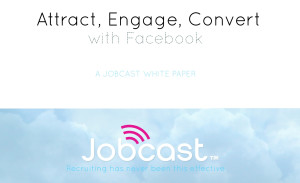Facebook ads are my favorite tool for social recruiting. Whether you want to reach passive candidates (and seeing as they make up 86% percent of the workforce, who wouldn't?), increase application volume (obviously!), reach more qualified candidates (even better than quantity I'm told), improve retention (did you know that candidate failure often costs 1.5 times their annual salary?), or all of the above (um, YES!) Facebook ads are your best bet. In our experience Facebook ads can mean the difference between zero candidate interest, and a landslide of applications from qualified talent. In fact, we've helped many of our clients create effective Facebook ad recruiting campaigns that have done exactly this! Facebook ads have higher ROI, and a better click through rate than any other form of web ad. Facebook ads allow you to narrowly target candidates based on the skills you need. They can even help you build a talent pool of qualified candidates by encouraging them to like, and promote your Company Page. The Jobcast team has learned a lot in our years of experience using Facebook ads to help employers succeed at social recruiting. We've compiled some of the best tips and tricks we've found and created this white paper to share that knowledge with you! Download our free white paper guide to Facebook ads now, and improve your hiring today!
Read MoreFacebook Recruiting
Targeted Facebook Ads are the best tool for reaching the right candidates for your jobs. With Facebook Ads you can ensure that your job posts and Career Page connect with candidates who have the skills your company requires. Narrowly targeted Facebook Ads reach their intended user base over 90% of the time! And, the ROI on Facebook Ads is five times higher than typical web ads because they give you access to Facebook’s massive social graph. Download this white paper and get all of the information you need to start using Facebook ads to connect with qualified candidates now! You’ll learn how to:
Reach candidates who have the skills your jobs require
Make your job posts viral
Target talent based on cultural fit
Optimize your recruiting ROI
Plan smarter hiring campaigns
Read More
Hiring for fit is awesome.
In case that last week’s article wasn’t enough to convince you of this, then how about this:
“50% of hires fail within the first 18 months on the job”
Okay, so that stat doesn’t actually say anything about hiring for fit… But when we look at why those hires typically fail, we see that it’s almost entirely due to the (ex) employee’s inability to mesh with their company’s culture and get along with co-workers and superiors.
In fact, only around ten percent is due to incompetence or lack of skill, while the rest is entirely due to a lack of fit.
Hiring for fit is pretty tricky though. You need to have a solid understanding of your own company: the management style, the culture, and the different personality types that exist within your team already. Bonus points if you can identify some personality types that are missing from your current team dynamic that would improve productivity or moral. Then, you’ll need to figure out what it is that makes employees excel at your company, what makes them fail, and how to find candidates who will fall into the former category.
Exhausting!
Thank goodness for 7 Geese.
Bet you thought I was going to try and tell you how to do all of this myself, didn’t you? No way. That is so not my area of expertise. This article, by the good folks over at 7 Geese, will give you a killer strategy for figuring out how to identify your company’s values and culture, and then how to interview effectively for cultural fit.
What I’m going to try and help you do is use Facebook ads to hire for fit.
Let’s go!
Create a candidate profile
What does your ideal candidate value? What kind of skills do they have? What kind of interests might they have? You can profile your best employees to help you get ideas on this. The same traits that make them so successful, are traits you may want to look for in new employees.
Just be careful not to hire clones of your top performers; Dig deep and figure out an assortment of personality traits that make these employees such a great fit for your company.
For example:
On employee may be a great fit because they are passionate about their job, and they have a communication style that meshes with your clientele. Another employee’s success may be due to their emotional intelligence, organizational skills, and the fact that their personality type fits nicely with the management style of your leaders.
Once you have this information all written out, you can figure how best to target for these traits using Facebook ads.
Appeal with visuals
Start slow. Do this by selecting some images, preferably of your actual staff, that showcase your company culture, specifically the aspects of your culture that will appeal to your ideal candidate.
For example:
If you are looking to find tech-savvy talent, who are always up on the latest gadgets and trends, then use pics that show off some of the awesome technologies that your company has to offer: Imagery, perhaps, of staff working on high quality laptops, showcasing interactive technologies that facilitate collaboration.
If you have the option, showing a recruiting video, geared specifically to candidates who fit your culture, is one of the best possible tools you can use to boost engagement and, in turn, your reach.
Or, just offer them an iPad mini… Up to you!
Use demonstrative language
Express your company’s values clearly in your ads, and use behavioral terms. If ambition is a key value that your employees must posses in order to succeed at your organization, use a call to action that conveys this.
For example:
“Are you the kind of person who loves to set lofty goals? More importantly, are you the kind of person who actually reaches them? If so, apply now. We want to work with you!”
Use ALL the tools
Facebook ads allow you to target candidates based on their interests, Likes, and other key personality traits. This is a bit more advanced than the previous options, but according to Facebook’s metrics, narrowly targeted Facebook ads reach the right user 90% of the time. Don’t be afraid to get specific.
For example:
If you are looking for candidates who are extremely driven and hard working, try searching for people who “Like” the Pages of like-minded experts, such as Sheryl Sandberg (not to be overly obvious) and have interests that demonstrate drive. Triathlons, for instance.
If you are looking for a team player to fill a creative role, then target candidates who play team sports, and who have chosen to follow creative types, like Seth Godin.
ALLLL the tools!
Check out these resources for more on how to use Facebook ads and on how to target for fit:
I hope these tips help you hire some amazing people who make your company culture even better than it already is!
If you have any tips on hiring for fit, or any topics you’d like to see covered on the blog, let us know in the comments.
And, don’t forget to sign up for our news letter. It makes us all so very happy when you do 🙂
Read MoreRetention is one of HR’s primary mandates. High turnover costs organizations tons of cash and man-hours, it disrupts team dynamics, and is just plain stressful.
To quote everyone’s favorite meme: Ain’t nobody got time for that!
When most of us discuss retention, we start the conversation post-hire. We look at incentives, engagement, and boosting employee morale. I recently wrote a blog post about creating a culture of retention that discussed exactly these points, but as important as all of those factors are, they don’t address the importance of recruiting.
Recruiting for cultural fit is almost always discussed as a means to maintain company culture and brand. This is why we end up with some articles arguing that hiring for fit leads to a lack of innovation caused by homogeneity. In truth though, hiring for fit has absolutely nothing to do with selecting candidates who are all exactly the same.
Hiring for fit is about finding candidates who:
Love what your company does
Have similar values to your organization
Will get along well with their future coworkers
Compliment the rest of your team with their skill set
Have a style of work that meshes with your other employees
Have similar priorities to your staff and organization
I would argue that these traits matter more than work history, education, and demographics combined.
I’ll use an example to better explain why I think this is true.
A friend of mine recently acquired a new coworker, let’s call him Pickles. Now, Pickles has fantastic credentials: he has a great education, has worked for some impressive companies, and, on paper, he blew all the other candidates out of the water. So, obviously, Pickles got the job.
Unfortunately, Pickles is also a know-it-all, who won’t follow directions, is extremely combative with both superiors and peers, and is about as disorganized as they come. He is both an energy and productivity vampire.
Pickles is about to be demoted, while his coworkers are really, really hoping he gets fired. Which makes them feel guilty, which leads to them feel resentful, which further hampers the team’s overall productivity.
Darn you Pickles!
Now, what if the team had hired Mustard? Sure, she went to community college, and she’s only been working for just over a year, but she is passionate about her industry, loves learning new things, and is so organized she doesn’t even need to use the reminder app on her iPhone, but she still does, just in case!
Mustard may have needed a little more specialized training, and taken a little more time to get familiar with industry specific technologies, etc… But, even the most experienced candidates need at least some re-training to work in accordance with company standard. Mustard is a fast learner too, so she would have caught up in no time, and once she had, she would have made a much better employee than Pickles.
In case you couldn’t tell, my friend was really gunning for Mustard!
If you’re with me in your love of Mustard, and candidates like her, then the question becomes: How do we track down the Mustards of this world? How do we find candidates who fit?!
With Facebook, Grasshopper. It always comes back to Facebook.
Using Facebook Ads, you can target candidates that fit with your company culture, and even more importantly, the team you currently have!
LinkedIn makes work history, education, and skills the focus of their profiles; Facebook includes all of these categories, but makes interests, and “Likes”, a priority with their profiles.
Thanks to graph search, you can either use this information to source candidates, or to target them with recruiting ads that take a more comprehensive approach to candidate profiling. An approach that includes a candidate’s interests, hobbies, and any other traits that may give you insight into their character.
Stay tuned next week for a revamp of our guide to Facebook ads, and some more specific ways that you can use Facebook to hire for fit.
Have a fantastic week, and happy social recruiting!
I’m off to make a sandwich. No Pickles.
Read MoreYou are all super savvy about hiring trends, of course you are… you read this blog! So, you all know that mobile is very important when it comes to social recruiting. What you may not know, is that the importance of having a mobile hiring strategy is even greater when it comes to recruiting passive candidates.
Passive candidates choose mobile over desktop, when looking for work, even more frequently than their active counterparts.
This probably has something to do with the fact that they are currently employed, and can’t exactly spend their days researching job posts on their company computers! In fact, many of the candidates you’re looking for don’t have any access to a computer while at their job. Retail workers, for example, spend their days on the store floor, making sales, dusting display units, and checking their Facebook accounts. They are also checking out potential employers on their smart phones.
In a recent survey by Jobvite, 21% of passive candidates admitted to using their smart phones to look for a new position, when at work. Naughty! Those candidates are also looking for work while they wait for the bus, while they wait for their morning muffin, and even while they use the restroom (at least 7% of them!)
So how do you get your job posts onto their smart phones, their iPads, and into their restrooms?
Tweet your job posts
Twitter doesn’t really work as a primary social platform for recruiting. It does, however, make for a top notch second in command. Twitter is a quick easy, way to let people know you’re hiring.
I like to break down effective strategy for using Twitter to improve mobile recruiting into three steps: build it, tweet it, tag it!
Build up your Twitter employer brand by posting images, sharing quick tips, and interacting with other tweeters in your field.
Tweet your jobs. Every time you post a job, tweet it, and then tweet it again! Twitter feeds fill up quickly, so you should tweet the post at least a couple times a day until the position is filled. Just make sure to intersperse those tweets with other valuable content.
Tag everything you post, everything! Use niche hashtags to make your tweets searchable, this will build your brand and talent pool. Tag your job posts with #hiring. Always, always, always #hiring! Mostly because this is the number one hashtag career advice bloggers tell job seekers to look for.
Here are the top 50 hashtags you should use when recruiting with Twitter.
Make your application process mobile friendly
Most career sites are not mobile; in fact, our own survey found that around 90% of career sites were not mobile friendly. This has got to change! But, until it does, there are some ways around it.
Use social networks to share your jobs. Yet another way Twitter can benefit your passive candidates recruiting! Take advantage of the mobile friendliness of apps like Google+, Instagram, and Facebook to get your job posts seen.
You can also create a Facebook career section for your company Page and post your jobs there. Your career section will be viewable to Facebook users via their mobile app, so all those passive candidates, who really ought to be working, can be looking at your job posts instead! Win-win!
Here’s how you can make your Facebook recruiting mobile friendly
Focus on Facebook over LinkedIn
Yes I am biased. No this is not the (only) reason I am giving you this advice.
84% of job seekers are active on Facebook. Only 36% of them are active on LinkedIn.
Nuff said.
Oh, except that passive candidates are even less likely to use LinkedIn in their job search, or to have up to date LinkedIn profiles (if they have one at all). LinkedIn is still a useful tool for connecting with other professionals and recruiting them, but for reaching the vast majority of passives candidates, hourly workers, and anyone under 35 Facebook is a better bet.
This article does a great job of explaining the difference between LinkedIn and Facebook for recruiting
Hopefully you’ve found some helpful info to help you recruit some passive talent. If you have any questions, or other topics you’d like us to cover, let us know in the comments.
Happy social recruiting!
Read MoreJust to recap: Passive candidates are magical unicorns. They will instantly improve your business, upgrade your company culture, and double your chances of winning the lottery.
Recruiting passive candidates will solve all of your problems!
Sadly, this is extremely difficult to do because passive candidates live in a land without help wanted ads, job boards, or desktop computers. It’s a scary place.
Annnd back to reality.
Passive candidates are not the be all end all of recruiting. They do, however, make up a huge percentage of the labor market (80%), they tend to need less skill development (around 17% less), and they also tend to be more driven once hired.
Why recruiting passive candidates has higher ROI than you think
The part about passive candidates being hard to reach was a little more realistic. These candidates already have employment and are not actively seeking work in the traditional sense. So, no, they usually aren’t looking on job boards.
But, many of them are interested in new career opportunities, 61% of them according to Jobvite. They may not be actively looking, but they are open to being contacted by a recruiter, and if they stumble across a really cool job post, they’ll happily apply.
Last week we talked about how to use social to source passive candidates. This week we’re going to focus on how you can get your job posts seen by those candidates.
No surprises here, the best way to reach passive candidates is social recruiting.
The Why
Passive candidates may not be checking the help wanteds, but they are checking their Facebook accounts (76% of them every day, often multiple times per day!) This means that you can use Facebook’s targeted ads to reach the candidates you can’t reach with traditional recruiting channels.
The How
First you need a company Facebook Page. I’m going to assume most of you have one of those already. If you don’t have one, it’s actually pretty easy to set up. Whether you plan to use it for recruiting passive candidates or not, you need a Facebook Page!
Here’s a simple guide to setting up a Facebook Business Page.
Next you’ll need to create a Facebook Career Site. It’s important that your Facebook Career Site is customized to your employer brand. Brand consistency is important because it makes your Page look legitimate which is important for garnering potential candidates’ trust. Building a fully branded Facebook Career Site will also help you gain social proof, and grow your employer brand’s internet presence in general.
Here’s how you can get started building a Branded Facebook Career Site
Now you’ll need to post some jobs, and promote the heck out of them!
As much as I would love to tell you that all you need to do to reach candidates with Facebook is post a few jobs, share them, and then get back to the one million other things you need to get done… It’s just not that easy.
Like all good things, Facebook recruiting does take effort. Luckily, it doesn’t take a lot of effort. In fact the ROI is quite high according to most recruiting surveys (the Jobvite, and Bersin recruiting studies to name a couple.)
If you want your posts to reach passive candidates, using Facebook Targeted Ads is the most effective way to do it. With FB Ads you can target users based on their demographics, work history, skill set, and interests. This means that your job posts will reach not only more potential hires, but the right potential hires.
Here’s a step by step guide to using Facebook Ads for recruiting
Using Facebook Ads is currently your best option for targeting passive candidates, and converting them into applicants. But ads aren’t the only reason Facebook is a great platform to reach these potential hires. You also need to take mobile, user demographics, and industry requirements into account…
Wow, this article got long.
You must be exhausted.
We’ll cover why mobile is extra important when trying to reach passive candidates, why LinkedIn (although totally rad) is probably not your best bet for recruiting passive candidates, and how many times I can type the words “passive candidates” before developing a nasty case of carpal tunnel.
Happy social recruiting everyone!
Read MoreOh, the ever-elusive passive candidate! Part of what makes them so desirable is that elusiveness, the fun of the chase, the challenge... Uhhh wait a minute. Those are actually all of the things that make recruiters prefer to target active job seekers, and ignore the whopping 79% of potential candidates who are not actively engaged the job hunt (Undercover Recruiter). Those candidates may be currently employed, and more difficult to source, but they are still potential hires. Maybe not all 79% of them, I'll admit that's a bit of an overstatement, but not as much as you might think! According to Jobvite at least 61% of those passive candidates are open to, even hopeful for, a change of employer. Considering that statistic, you're still looking at a whopping 50% of working professionals. That's a lot of potential hires to ignore. Ignoring those passive candidates doesn't just diminish your talent pool, it also rules out higher caliber hires. According to research by Linked in, although more difficult to recruit, passive candidates often make for better quality employees. Once hired, they are more driven than active candidates and 17% less likely to need skills development. This ups the ROI on passive candidates substantially. 2014 will see the need to add passive candidate sourcing to your recruiting strategy increase even more because of the current economic upturn. The economic upturn means more jobs, and fewer qualified active candidates in the job market. So, the market for quality talent is about to get a lot more competitive, we've written about it, Inc Magazine has written about it, and Blogging4jobs has written about it a lot! The war for talent is back, and with it comes an increased premium on talent, and the need to get more active with your recruiting. Luckily for employers, sourcing and recruiting passive candidates is a heck of a lot easier than it once was. With today's social technologies, and social graph in particular, sourcing passive candidates is a piece of cake! Alright, so I'm exaggerating again, but with all that big data at your finger tips, passive candidates are more accessible than ever before. With social recruiting, you can search for potential hires based on information they’ve shared about their work history, their interests, their demographics, and even their skill set by using networks like Facebook. The social graph is constantly getting bigger and as it does, using social networks to source passive candidates will get easier. This is great news, because sourcing is hard work! And the benefits of social for accessing passive candidates don’t end there! Social platforms also make it possible to reach out and engage with passive candidates. They may not be visiting your career site, or looking on job boards, or even have a LinkedIn profile, but now a day’s pretty much every single human (in the first world at least) has some form of internet presence. Heck, there were over 35 million #selfies posted on Instagram last year. There are 231.7 million active monthly users on Twitter, Google plus adds 25, 000 new users on the daily, and Facebook accounts for 16% of total internet use. If you can't reach candidates via job boards, you can tweet at them, connect with them on Facebook, add them to your G+ circles, and even heart their excessive Instagram selfies. People love it when you double tap their #selfies! Next Monday on the blog we'll explore how you can use social media to recruit passive candidates, and take over the world! If you want to study up before next week's blog post, download this free white paper and learn how to recruit passive candidates with Facebook. Happy social recruiting!
Read MoreWe recently had a fantastic comment on our post about making Facebook work for small business.
In it, our reader asked just how targeted Facebook really is, whether Facebook recruiting is effective without an existing audience, and, in summary, whether or not Facebook recruiting is any different from placing an ad in a local newspaper. That last question is what really got my attention, and not in the way you might think. Using social media to recruit is different from using non-social media in very obvious ways. But, what I think we do not talk about enough, in the field of social recruiting, are the similarities between using networks like Facebook to promote job openings, and using the career section of your local paper. Facebook Recruiting is NOT magic. It is awesome, it is effective, it has high ROI... Facebook recruiting works, especially if you use a top notch recruiting app, just saying... But, no, sadly Facebook recruiting is not magical. Like placing an ad in your local paper, using a company career site, and recruiting with job boards, Facebook recruiting takes work, time, and a budget (albeit a relatively small one!)
Similarity Number One: Effort.
"The only place success comes before work is in the dictionary" - Inspirational poster on the internet
I wish that it was possible to simply share a job post and receive a flood of resumes. Actually, I don't because then I would be out of a job... But it would be very nice for all the employers and recruiters out there. Like with any other kind of recruiting campaign, social recruiting takes work. You will need to create content, build up an employer brand, and engage with Facebook users that you would like to see become part of your talent pool. Why Facebook is Better:
Unlike placing ads in the paper, and posting on job boards, when you use Facebook to recruit, all of the content you share, the work you put into your employer brand, and the effort you put into engaging with users, will also build your company brand as a whole. You get to combine recruiting with improving your overall social media presence, which is so important in today's heavily online driven markets. Similarity Number 2: Time.
Writing a quality job post takes time. Researching how you should promote those posts once written takes time. Building a trustworthy, recognizable employer brand takes time. You'll need to build a recruiting strategy, figure out how to write effective job posts, and promote your company culture no matter what medium you choose to employ. Why Facebook is Better:
Social sharing. Unlike print, job boards, or even LinkedIn, Facebook is a medium primarily built around interaction. The structure of the network its self encourages users to share, comment and Like your company's content, which means their connections are more likely to see your job posts. And, Metrics! Facebook Insights makes it pretty darn easy to figure out what works and what doesn't when it comes to your recruiting strategy. Using data to fine tune your recruiting campaigns is one of the best ways to cut down on the amount of time (and work) you have to spend on them in the future. You can also use a Facebook recruiting app like Jobcast to help you measure more recruitment specific data! Similarity Number 3: Budget.
The best things in recruiting are not free. Sure, there are some pretty great free options when it comes to Facebook recruiting, but if you want access to the most effective features the social network has to offer, you're going to have to invest a little capitol. Print ads cost money, quality job boards cost money, and hiring recruiters definitely costs money! Why Facebook Is Better:
It costs less. It's that simple. Ed Social Media explains how they were able to run a successful ad campaign for a mere $20 dollars. Running ads in print news papers often costs upwards of $500 (and that's for a small paper) which is much, much more expensive. Not only do Facebook Ads cost less, but they give you more. Facebook Ads allow you to target users based on their work history, skill set, and interests. Print journals may advertise circulation rates in the tens, even hundreds of thousands, that's a lot of potential viewers, but often those rates are exaggerated, the demographic is completely wrong for your jobs, and no one can tell you how many of those readers even flip to the wanted section of the paper! (Yet another great thing about Facebook Insights!) This incredibly comprehensive article by Jon Loomer will give you a better understanding of what Facebook Ads campaigns should cost. You can also check out our free white paper for a step by step guide to Facebook recruiting.
Read MoreSo apparently 2013 is practically over.
Did this year go by super fast or what?
It’s probably all the exciting and cool social media innovations that make it feel this way. Vine Video, Upgraded Facebook Ads, the introduction of Facebook Skills, Tinder… The list goes on, and on, and on! It’s been an incredible year for social recruiting, and for all of us at Jobcast.
The Jobcast Facebook Recruiting App went completely mobile, we released our first white paper (a how-to guide for Facebook Recruiting), filmed a Vine recruiting video, co-hosted an awesome webinar with Indeed, were featured on the cover of HR Insights magazine, and our talented CEO, Ryan St. Germaine, gave an inspiring talk at Six:Forty.
It’s been a very good year.
No one wants to read about what’s already happened though. Predictions are where it’s at. In fact, our most popular blog post to date was our social recruiting trends for 2013. And, I hate to brag (that is a bold faced lie!), but ALL of our predictions totally held up.
I could skip the whole prediction thing and stick with a year-end review… You know, play it safe to keep my batting average one for one, but I prefer to live life on the edge.
It’s time for the Social Recruiting Trends 2014 predictions to begin, and I’m going to start with a risky one.
Facebook Goes Professional
Facebook is losing some traction as a means of connecting with close friends and being social in a personal way, but its user base just keeps growing. I predict that many of these users will use Facebook to connect with potential employers, companies, and peers in their field of work.
The introduction of Facebook skills, and the huge rise in the number of companies that are using Facebook to recruit, makes this shift seem more than just possible — almost inevitable.
This prediction is purely my own. I have no data to back me up, other than observing job seekers and my peers, but risky predictions are the most exciting. Let’s see what happens!
Mobile-Optimization or Death
Last year we predicted the rise of mobile recruiting, and we were right. 1 in 6 Facebook users access the network exclusively through mobile. Over 60% of job seekers are using mobile to look for work, and 40% of potential candidates will abandon the application process if it is not mobile-friendly.
Which brings us to our prediction: Mobile friction will become the main deterrent to candidates completing the application process. Failing to have a fully-mobile career site and application process is NOT an option in 2014. Your social recruiting must go mobile.
Niche Recruiting
Gone are the days of simply sending out job posts, and praying that they get seen by candidates who fit your company’s needs, instead of just 12-year-olds and cat ladies with nothing else to do but hang out on the internet.
With all of the data that employers now have access to, and the improved ability to target these candidates based on that information (thank you Facebook Graph Search), social recruiting will become more about reaching a very specific group of candidates.
Recruiters and Employers can use HR Tech to mine data in order to determine exactly what they should be looking for in a potential hire, and then use social networks to find candidates that match that. Equipped with this knowledge they can use Facebook as a tool to find, engage and attract those niche candidates.
Facebook Ads, especially after their recent updates, allow you to reach these candidates easily, as you can get very specific about the audience that they target. This means you can use them to direct job posts to the eyes of those potential hires you most want to reach.
Facebook’s introduction of professional skills to users’ profiles, and they way that they encourage them to connect with others with similar skills by pushing them to related groups and Pages, also gives you a great “in” with specific groups of candidates. You can seek out passive candidates based on the skills they’ve entered and either make contact directly, or you can join groups related to the skills you are looking for in future employees, and engage with users that way.
Facebook just keeps getting better for social recruiting!
Oh, and last but not least:
The Jobcast Facebook Recruiting App will take over the world (of social recruiting). That one is definitely true.
Happy New Years’ from the Jobcast Team. May 2014 see all of your recruiting dreams come true!
Read MoreHello, It is almost Christmas. So, if you celebrate that holiday, hopefully all of your shopping is done. If you celebrate it with gifts that is! My family celebrates with food mostly, but also presents. That is why it was pretty scary to wake up yesterday morning, realize just how close to Christmas it was, and that I had not yet even thought about shopping for gifts, let alone purchased any, and that I was going to have to actually leave my house, and maybe even enter a MALL. Thankfully all of my gifts are now purchased. I did have to venture outside, but luckily I managed to avoid the mall. Life is good! To celebrate, I thought I would give all of you, our awesome readers, a gift as well. It's the kind of gift that employers everywhere dream of: A free white paper about how to use Facebook for recruiting. I know, I know, there are a lot of white papers out there, but this one is full of great tips and tricks, has a really easy get-started guide, and is very thoroughly researched. It even includes real life examples! What's not to love? Check out our free white paper for an awesome guide to Facebook recruiting. Happy (holiday) social recruiting from all of us at Jobcast.
Read More








